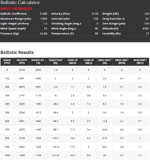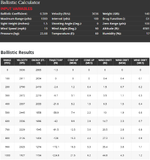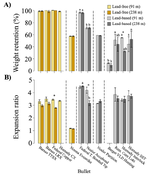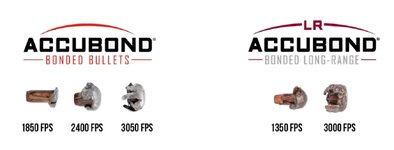- Joined
- Oct 22, 2014
- Messages
- 13,157
but on a mature bull slightly quartering-to with a 2" scapula to get through?
What animal has a 2” thick scapula?
Follow along with the video below to see how to install our site as a web app on your home screen.
Note: This feature may not be available in some browsers.
but on a mature bull slightly quartering-to with a 2" scapula to get through?
These exact questions have already been answered in this thread with exterior ballistics explanation that you blew off as semantics.10 grains, 14% more bullet on the ass end.
As I mentioned elsewhere above, your line of questioning can be as reasonably applied to virtually any single step up in any bullet weight of any cartridge.
To wit: what does the 140gr accomplish that the 130 won't?



Says the guy using unbonded Partitions that exhibit even worse weight retention?I think bonded bullets are a good design, but a lightly constructed bonded bullet that sheds 45% of its weight at a very slow 2400 fps isn’t anything I’m looking for.
Which one has given you more consistent exits?These exact questions have already been answered in this thread with exterior ballistics explanation that you blew off as semantics.
When you run the numbers, there isn't a good reason for the 140gr Accubond to exist, other than Fudds keep them selling for Wallop and guys that look purely at BC instead of the other impacts on Ballistics. Among the 6.5mm bullet Accubond family, the ballistically superior Accubond is the 130gr, and the ABLR is the 142gr, with the lowest Form Factor in their respective branches. Ballistically, those bullets will perform the best even at fairly extended range:
View attachment 885272
To illustrate the point, here's the ballistics for a 130gr AB and 140gr AB from a 6.5 PRC with a max charge of N560 in GRT. The 130gr AB outperforms the 140gr AB ballistically all the way out to 1000yds, despite the better BC of the 140. This is how Form Factors work:
130gr AB:
View attachment 885273
140gr AB:
View attachment 885274
I'm sure you could cherry-pick velocities from some random reloading manuals that would show different results, but that's not a direct comparison. Note the above values are for my shooting elevation.
That's numbers and facts. The rebuttal may be some more handwaving and deflecting about the use of semantics or rambling about up-armored elk, but there's the answer to your question in data. Nosler makes the 140gr because it sells, not because it's a better bullet.
Neither. Gamekings were my 6.5mm bullet of choice. I’m planning on switching to 107 TMKs this year. I’ve carried 120 Nosler BTs, but haven’t found anything bigger than a yote to put them in.Which one has given you more consistent exits?
Interesting. Thanks for posting. Can you post the 150 ABLR results? Thanks in advance.These exact questions have already been answered in this thread with exterior ballistics explanation that you blew off as semantics.
When you run the numbers, there isn't a good reason for the 140gr Accubond to exist, other than Fudds keep them selling for Wallop and guys that look purely at BC instead of the other impacts on Ballistics. Among the 6.5mm bullet Accubond family, the ballistically superior Accubond is the 130gr, and the ABLR is the 142gr, with the lowest Form Factor in their respective branches. Ballistically, those bullets will perform the best even at fairly extended range:
View attachment 885272
To illustrate the point, here's the ballistics for a 130gr AB and 140gr AB from a 6.5 PRC with a max charge of N560 in GRT. The 130gr AB outperforms the 140gr AB ballistically all the way out to 1000yds, despite the better BC of the 140. This is how Form Factors work:
130gr AB:
View attachment 885273
140gr AB:
View attachment 885274
I'm sure you could cherry-pick velocities from some random reloading manuals that would show different results, but that's not a direct comparison. Note the above values are for my shooting elevation.
That's numbers and facts. The rebuttal may be some more handwaving and deflecting about the use of semantics or rambling about up-armored elk, but there's the answer to your question in data. Nosler makes the 140gr because it sells, not because it's a better bullet.
[Where are you finding a 2" thick scapula? I've butchered a lot of animals (wild and domestic) and never seen a scapula that was thicker than 3/4" unless you are counting the tiny scapular ridge in your measurement. Muscles on the scapula are soft and have no way of being bullet proof. The scapula in itself is a soft and brittle bone with little that would prevent penetration from a bullet above terminal velocity.
Jay
Gonna need you to point me to what you're referencing in the first part.These exact questions have already been answered in this thread with exterior ballistics explanation that you blew off as semantics.
I'm sure you could cherry-pick velocities from some random reloading manuals that would show different results, but that's not a direct comparison. Note the above values are for my shooting elevation.
That's numbers and facts. The rebuttal may be some more handwaving and deflecting about the use of semantics or rambling about up-armored elk, but there's the answer to your question in data. Nosler makes the 140gr because it sells, not because it's a better bullet.
So no experience with them in the 6.5. I judge bullets by whether or not they’re more apt to exit instead of numbers on a chart. I’ve found that that usually doesn’t tell the whole story.Neither. Gamekings were my 6.5mm bullet of choice. I’m planning on switching to 107 TMKs this year. I’ve carried 120 Nosler BTs, but haven’t found anything bigger than a yote to put them in.
The last animal I took with an Accubond was a cow elk. 160gr 7mm Accubond left no exit. Same story with the two 150gr .277 Accubonds I’ve put into mule deer. All shots between 300
and 400yds, none have gone further than 20ft. All three bullets were collected on the offside hide where a bulge in the skin was visible.
The PRC adds around 300fps to that impact velocity, and would drop to 2700 at 200 yards. On a 10"-thick aoudad it would make little difference, but on a mature bull slightly quartering-to with a 2" scapula to get through? I'm sure it would kill but I'm not sure the AB of same weight wouldn't drive deeper by opening slower.
You stated there were 2" thick scapula. What animals do you find them on?Gonna need you to point me to what you're referencing in the first part.
Say you don’t understand how Partitions work without saying you don’t understand.Says the guy using unbonded Partitions that exhibit even worse weight retention?
Data doesn't lie. Turns out a bonded bullet retains more weight under controlled test conditions than the vaunted Partition with a front core that's free to depart the moment it gets upset. That must be some darn good glue they're bonding those Noslers with.Say you don’t understand how Partitions work without saying you don’t understand.

I know "no experience" is the answer you were probably fishing for, but crunch the numbers and you'll see both those bullets are highly relevant to this discussion.So no experience with them in the 6.5. I judge bullets by whether or not they’re more apt to exit instead of numbers on a chart. I’ve found that that usually doesn’t tell the whole story.
The one elk I shot with my 160 grain AB in my 7 SAUM exited(both shots). Had exits on all three shots in my mule deer with a 140 grain AB from my 7-08. But, it was alot closer than what yours were. Lol
Thanks!150ABLR:
View attachment 885321
Same premise here. Though slipperier when looking at BC, the slower 150gr doesn't catch up to the faster yet slightly worse BC 142gr ABLR. Another fine example of form factor at work:
View attachment 885322
You're right, you used the word sentiment, not semantics. Sorry, I got my wires crossed with replying to RollPin.[
Gonna need you to point me to what you're referencing in the first part.
As for the ballistics calculations I haven't argued against bullet drops or retained energy or wind drift nor anything else at range. Not sure anyone else has.
However those numbers say very little about terminal performance, and sectional density does matter. As does bullet design after impact.
Not here to convince anyone what bullet to choose, but to find share interest in what I see as a hole in the AB lineup.
If your stance is that no one needs a 150gr AB precisely because no one even needs the 140, I've got you marked down as a "no."
Note: bonded bullets are not "glued" together in any case that I know of. (though some processes are proprietary, so hey, it's not impossible).
Since I'm sure you didn't take the time to read the paper I posted during your tirade last night, here's the relevant graphic. About 15% better weight retention on the Accubond at both ranges relative to the Partition:
View attachment 885319


You’re the one that brought up retained weight, no one else.If retained weight is the only important metric for bullet performance we’d all be shooting monos. I like the high retained weight of the Accubond since it creates a nice medium size wound cavity that’s quite uniform, but I haven’t seen that they perform any better than Partitions - I like that the front portion expands rapidly and the remaining 70% penetrates quite well. All the Partition shooters that I’ve chatted with who have switched to Accubonds say they aren’t worse and the extra BC is nice, but none give the impression they are better. My gut feeling is Accubond shooters will repeatedly bang their heads on the wall that Nosler hasn’t upped the weights and BC to match the long range version, but it will eventually happen. I started to switch to Accubonds, but I’m waiting until heavier weights come out. The ABLR is just too soft for most Partition and Accubond shooters to consider switching. In the mean time I enjoy shooting a bullet that was designed in the 1940s while constantly asking all you guys why the current bullets aren’t clearly much better. They should be better after nearly 80 years!
View attachment 885357View attachment 885356
